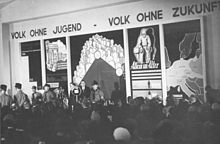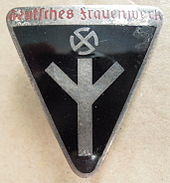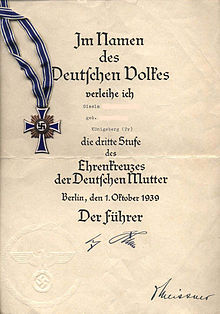
Back النساء في عهد ألمانيا النازية Arabic নাৎসি যুগে জার্মানির নারী Bengali/Bangla Dones a l'Alemanya nazi Catalan Frauen in der Zeit des Nationalsozialismus German Mujeres en la Alemania nazi Spanish زنان در آلمان نازی Persian Condition des femmes sous le Troisième Reich French Žene u Trećem Reichu Croatian Wanita di Jerman Nazi ID Donne nella Germania nazista Italian
| Part of a series on |
| Women in society |
|---|
 |

In Nazi Germany, women were subject to doctrines of Nazism by the Nazi Party (NSDAP), which promoted exclusion of women from the political and academic life of Germany as well as its executive body and executive committees.[1][2] On the other hand, whether through sheer numbers, lack of local organization, or both,[2] many German women did indeed become Nazi Party members. In spite of this, the Nazi regime officially encouraged and pressured women to fill the roles of mother and wife only. Women were excluded from all other positions of responsibility, including political and academic spheres.
The policies contrasted starkly with the evolution of women's rights and gender equality under the Weimar Republic, and is equally distinguishable from the mostly male-dominated and conservative attitude under the German Empire. The regimentation of women at the heart of satellite organizations of the Nazi Party, as the Bund Deutscher Mädel or the NS-Frauenschaft, had the ultimate goal of encouraging the cohesion of the "people's community" (Volksgemeinschaft).
The ideal woman in Nazi Germany did not have a career outside her home. Instead, she was a good wife (however her husband defined that), a careful and conscientious mother (taking special care to raise her children in accordance with Nazi philosophies and ideals), and skilled at doing all domestic chores such as cleaning and cooking. Women had a limited right to training of any kind; such training usually revolved around domestic tasks. Over time, Nazi-era German women were restricted from teaching in universities, working as medical professionals, and serving in political positions within the NSDAP.[3] With the exception of Reichsführerin Gertrud Scholtz-Klink, women were not permitted to carry out official functions. However, there were some notable exceptions, either through their proximity to Adolf Hitler, such as Magda Goebbels, or by excelling in particular fields, such as filmmaker Leni Riefenstahl or aviator Hanna Reitsch. Many restrictions on women were lifted once wartime necessity required policy changes later in the regime.
The historiography of "ordinary" German women in Nazi Germany has changed significantly over time; studies done just after World War II tended to see them as additional victims of Nazi oppression. However, during the late 20th century, historians began to argue that German women were able to influence the course of the regime and even the war. In addition, these studies found women's experiences during the Nazi regime varied by class, age and religion.[4]
While many women played an influential role at the heart of the Nazi system or filled official posts at the heart of the Nazi concentration camps,[5] a few were engaged in the German resistance and paid with their lives, such as Libertas Schulze-Boysen and Sophie Scholl.


- ^ "La femme sous le regime Nazi". Histoire-en-questions.fr. Retrieved June 21, 2013.
- ^ a b Franz-Willing, Georg (1962). Die Hitlerbewegung. R. v. Deckers Verlag G. Schenck, Hamburg.
- ^ Stephenson (2001). Women in Nazi Germany, pp. 17–20.
- ^ Sharman, Fiona. "How has the historical representation of women in Nazi Germany changed since 1933?." Historical Social Research 20 (1995): 51.
- ^ Lower (2013). Hitler's Furies: German Women in the Nazi Killing Fields, pp. 97–144.